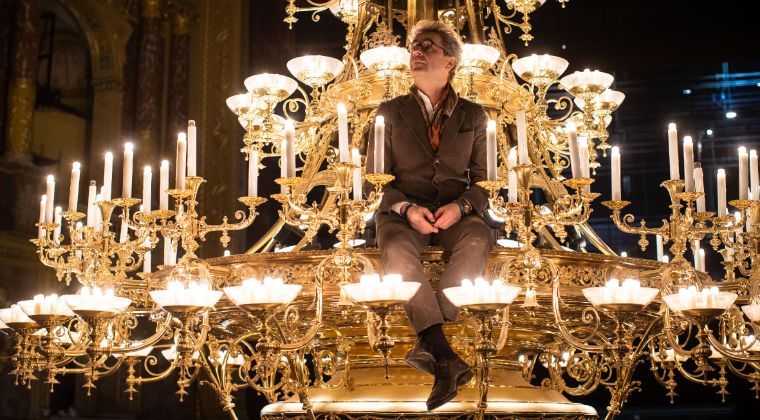In 2003, when Müpa Budapest was nothing more than a concrete shell, its architect Gábor Zoboki sat in what was to become the Béla Bartók National Concert Hall with conductor Ádám Fischer. “‘Gábor,’ he told me, ‘this is the Valhalla. We have to play Wagner here.’” In the decades that have followed, the yearly Budapest Wagner Days have become a major feature of the city’s musical landscape.
Zoboki had won a competition to design a new cultural centre to house their Ludwig Museum's collection of contemporary art. Zoboki was an architect by trade but a musician by inclination: his love of music started young and then burgeoned in the Dance House movement of the 1970s, when Hungarian folk dance venues became a focus of resistance to the communist regime's dominance of culture. He was taught piano by Magda Thománé Molnár, a pupil of Kodály’s, sang in choirs and then conducted them; he also composed. And he was convinced that Budapest needed a new concert hall.
“Everyone knows the Liszt Academy: it has a fantastic chamber hall for Viennese classical music, but it’s not compatible with Shostakovich or Bruckner or Mahler. And everybody knew that Hungary, the country of music, has never had a chance to build a hall where you could play Bartók’s Concerto.”
The Hungarian cultural authorities got rather more than they bargained for, as Zoboki lobbied tirelessly for the new arts centre to include a symphonic concert hall. He enlisted the help of top musicians such as Fischer, András Schiff and the influential Zoltán Kocsis, chief musical director of the Hungarian National Philharmonic. “An architect’s role is to push the decision makers”, Zoboki explains. “I worked for one and a half years to tell everybody that this 19th-century type of romantic music concert hall just has to be built in the neighbourhood of the new contemporary museum. And somehow, it was successful”.

Zoboki understood halls. For his graduation, he had done a long study (“which I wouldn’t like to torture you with”) of the inner workings of La Scala, Bayreuth and other great music venues of yesteryear. The single topic that still fascinates him most is how architecture, interiors and acoustics were done in the 19th century, and how this tradition might be followed into the 21st.
For Zoboki, everything in the design of a concert hall starts with its intended programming. “I did more than fifty interviews with musicians and all the stakeholders: Budapest Spring Festival leaders, culture ministers, choir leaders, everybody. Slowly, I could put together a programme. I emphasise this, because without a good programme, you can get a nice building which is never usable: there are a lot of examples in China or in Japan or even in Western Europe. If you have a city with two million inhabitants, how many seats in this type of concert hall will you need in the next 25 years? I started the design when we had a very clear music programme.” There were types of music that could not be performed in other venues in Budapest, for example the big organ symphonies of Saint-Saëns and Respighi: the new hall would need a big concert organ. During communism, the organs in Hungary’s churches and cathedrals had fallen into disrepair.
It was clear that the hall would need to serve many types of music with radically different requirements: “When Grigory Sokolov comes here, you also have to get an answer for a recital in the same room where Wagner fans would like to listen to Die Walküre.” So Zoboki set about asking as many musicians as he could find about what was required to produce a truly world-class hall. He spoke to Christian Thielemann (now Chief Conductor of the Staatskapelle Dresden). He visited Bayreuth, where Fischer was conducting a Ring and Parsifal. Zoboki reveres Fischer as “one of the greatest and most contemplative conductors – in his hands, Der Ring des Nibelungen is something which is not comparable with any other, Bayreuth, Paris or Vienna”, so when Fischer came to visit the hall and declared that it should be his Valhalla, it was a life-changing moment for Zoboki.
Doing Wagner, he knew, would need an excellent orchestra pit. The location of the pit under the canopy, one third of the way along the hall, has made opera-in-concert a far better experience than the typical concertante layout of an orchestra sitting behind the singers: “Turandot and Traviata are much better when the orchestra is in the pit because the sound is more balanced with the stage.” But the Béla Bartók National Concert Hall is not a conventional Wagner space, because Zoboki and Fischer’s intent was different from the Bayreuth ideal of achieving a wash of blended orchestral sound. Müpa is the exact opposite, he explains, with an “analytic” sound: “why you like to hear Wagner in Müpa is that you listen to all the notes which Wagner wrote, which is not normal in Bayreuth or in any other opera house.”
Unsurprisingly, the acoustic design was crucial. “Never say that acoustics today is a realistic science. The honest acousticians say that 50% of how a concert hall works is luck.” Zoboki counts himself as incredibly fortunate to have worked with the late Russell Johnson, whom he describes as a huge influence and “his second godfather”. He decries the typical conversations between “blind acousticians and deaf architects” where the former think only about acoustic elements and the latter only about aesthetics; his “professional marriage” with Johnson was ideal because “I am a musician and he was an architect.” For three years, the pair met every month, either in Budapest or in New York, working on every detail “from the piano lift to the pit arrangements from Figaro to Parsifal. Russell’s mania was adjustability: ‘Gábor, you have to understand that in 20 years, not as many Mozart concerts will be played in Budapest as in 2000’”.
The adjustability results from three distinct elements: reverberation chambers, curtains and a canopy above the stage. The chambers allow you to adjust the reverberation time of the hall – the time that it will take a note to die away – at different frequencies (a warm sounding hall can have a time of up to 2.4 seconds). To understand the use of the chambers, Zoboki asks you to imagine that you are sitting in the nave of a cathedral with rows of columns which open into the spaces towards the side walls. Larger openings will increase the reverb time at higher frequencies; smaller openings will push the brilliance on the low frequencies. Müpa’s reverb chambers can increase the overall volume of the hall by as much as 25%; fine tuning the adjustments for different types of music was a process that took three years after the hall was opened.
But there are some events which cannot handle the warmth of a long reverberation time, most notably anything with speech or amplified music. Müpa has to be used for many events of this type: for these, three layer black velvet curtains are deployed around the upper tiers to bring down the reverberation.
The canopy above the orchestra helps the musicians to hear each other. Because the stage opening is particularly wide, he explains, there can be a 24-metre distance between the leftmost double bass and the rightmost first violin. With the ceiling being very high (also 24 metres), you need reflective surfaces above the orchestra to allow the sound of one player to reach the others quickly: the Béla Bartók Hall has three levels of reflectors.
Johnson was a strong advocate of the shoebox hall shape, preferring it to the vineyard style of the Berlin Philharmonie, which has been considerably more in vogue in this century (Disney Hall, the Paris Philharmonie and the Elbphilharmonie are all vineyard halls). Zoboki agrees, pointing out that this is the style of some of the best loved 19th-century halls like the Musikverein or the Concertgebouw and you can never get the same warmth of reverberation in a vineyard hall. Also, it’s a closer match for opera sound and the horseshoe shape of a traditional opera house, where the first reflection you hear comes from the side (“your ears are on the side of your head”). In any case, he points out, “if we ever wanted to stage anything, you can’t do it with 2/5 of the audience behind you”. Another strong supporter of the shoebox was composer Péter Eötvös, who wanted to be able to place instruments at different levels in the room, which doesn’t work well in a vineyard style because the balconies get in the way of the sound.
Another important feature of the Béla Bartók Hall is its sheer volume relative to the audience size: at 25,000 square meters for an audience capacity of 1,656, that comes to 15 square meters per audience member, more than double the space in the Berlin Philharmonie. And although Zoboki loves the Philharmonie, he thinks it’s a unique hall because its architect Hans Scharoun was such a superb musician and that it’s broadly impossible to copy or emulate it.
In subsequent years, Zoboki’s work on Müpa has been developed further in halls like the Nanshan Cultural Center in Shenzhen, which he describes as “the most successful acoustics in my career”. The three tiers have been reduced to two and the reverb chambers have been located above the hall, creating a venue which can be used for spoken drama as well as music. He was amused by a magazine article saying “the genius architect has hidden the amplifiers somewhere and we don’t know how he did it” (there are no amplifiers). Back in Budapest, the reverberation chamber concept has been applied to the recent rebuild of the Hungarian State Opera House, which uses outsized ventilation grids under the stalls seats so that some of the sound from the orchestra pit reaches the audience from below.
Zoboki is currently working on a project to build a new 3,000-seat hall in the neighbourhood of Müpa, which will be mainly used for conventions but also allow events like larger scale concerts and film festivals. The two halls will act as twins, sharing facilities where useful, and he is currently considering the question of how to get the best value for money and operability from this kind of combined convention and cultural centre. The future of the project has been thrown into doubt by the economic shock from Russia’s Ukraine invasion, but he believes that Budapest needs the centre to attract higher-spending tourism and is hopeful that it will go ahead.
Twenty years after the Béla Bartók National Concert Hall’s foundation stone was laid, Hungarians can be happy that they have one of the great places in the world to hear Wagner, and grateful that Zoboki was able to reconcile his love of music with his parents’ desire to push him into “a real profession”. Perhaps it’s best to leave the last word to Fischer, who told him, after the first Budapest Wagner Days: “Gábor, if you would have been a conductor, you would have competed with me and you would never have built Müpa. And that would have been a shame for our country.”
This article was sponsored by Wavemaker Hungary, on behalf of MUPA.


